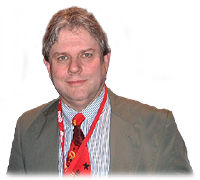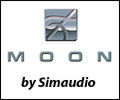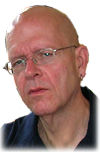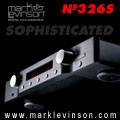
In This eNewsletter:
• 2006 Stereophile Buyer's Guide Now Available, by John Atkinson
• A Clean, Well-lighted Place, by Wes Phillips
• This Month's Audio URLs, from Wes Phillips
 |
In This eNewsletter: |
 2006 Stereophile Buyer's Guide, by John Atkinson 2006 Stereophile Buyer's Guide, by John Atkinson
The 2006 edition of the Stereophile Buyer's Guide is out now. Listing the specifications of more than 5000 audio components within its 212 large-format pages, the Buyer's Guide is exclusively concerned with products for music reproduction, as opposed to the bangs, bonks, and battle noises typical of movie soundtracks. In addition to the listings, Stereophile's editors and writers offer advice on how to get the best from LP playback systems, loudspeakers, amplifiers, and digital source components, while "Music in the Round" columnist Kalman Rubinson offers practical advice on setting up a multichannel music system. The 2006 Stereophile Buyer's Guide is available on newsstands, cover price $6.99. |
 |
Simaudio Ltd. Simaudio Ltd., celebrating 25 years of excellence, manufactures state-of-the-art components for both 2-channel and home-theater systems. Maintaining a world-class reputation, we continually push the performance envelope to the next level with each new product. Visit us at www.simaudio.com. |
||||
 A CLEAN, WELL-LIGHTED PLACE, by Wes Phillips A CLEAN, WELL-LIGHTED PLACE, by Wes Phillips
I remember the precise moment I became an audiophile. It wasn't when I joined the A/V club in high school—that just meant I was a geek. It wasn't when I bought a quadraphonic synthesizer, although I did stop using it because it sounded bad. No, I became an audiophile when my friend Bill pressed his tattered copy of one of the 1979 issues of Stereophile (which he pronounced Stereofeel) into my hands and said, "I think you'll really like this guy." I did—when I finally met that guy, J. Gordon Holt, 15 years later. I also liked another guy who was introduced in that issue, for a subsequent issue announced that Gordon was selling Stereophile to Larry Archibald so that Gordon could devote himself to what he did best: writing about hi-fi. That issue changed all of our lives. Larry had no clue what he was letting himself in for. Gordon, freed from the scut work, continued turning out masterful reviews (and more of them), and I discovered that there were people out there who were just like me. It was like coming home to a place I'd never been. I read that copy of Stereophile until it was falling apart, and, since Bill had given it to me as I boarded the train to New York, I carried it with me when I went around my new hometown looking for a job. I read about the Final Audio Research Turntable (what an acronym) and plasma tweeters, and I wondered how on earth you could ever get a chance to actually hear some of that stuff. Funny thing—a friend of a friend heard about a job I might be able to get, and he told me to go to a place off Canal Street and use his name as a reference. Two hours later I was in the lobby of a record pressing plant, squirming as the co-owner asked, "So you know Bob Ludwig?" I didn't, of course. I was so green I hadn't even heard of A-list mastering engineer Bob Ludwig. "No," I said, "but he's a friend of my wife's best friend's cousin and he remembered that you said you were looking for someone. I thought if you interviewed me, you'd want to hire me, and he said his name would get me in the door." They must have been desperate; I started the next day. I was actually working in the world of audio, though I still knew precious little about it. We had Infinity RS 4.5 loudspeakers in one quality-control room, Quad ESLs in another. We were the plating facility that Bob Ludwig, Ted Jensen, and Jack Pfeiffer specified for their pet projects. And we had fascinating customers calling all the time. One day, I spotted a classified ad in the Saturday New York Times—which, I had discovered, was where the high-end audio ads ran. It was a call for members in a new audio society. It was exactly what I needed—a place where I could talk to experienced audiophiles and learn about gear, pressings, gear, turntables, and gear—and this new stuff I'd just heard about, audio cables. The more I thought about it, however, the more uncomfortable I got. At the time, I owned and listened to a pair of Acoustic Research 2ax speakers with a smoothing cap across the terminals, powered by an Advent receiver, which was driven by an original AR turntable I had modified myself. I'd bought the AR second hand, without a dustcover, and had one of the Canal Street acrylic shops build a cover to my specs—mine was better than the original, because I could play records with it on, which effectively cat-proofed it. But even though I logged many happy hours listening to music on that system, it didn't seem impressive. I thought I'd be laughed out of the meeting by "real" audiophiles, so I never went. Actually, not many people did. When, in 1994, I met the guy who'd placed that ad, he told me that the guys who did show up would have loved being thought of as experts and mentors. It took me years to figure out one of the basic appeals of any enthusiasm: The best part about having a hobby, obsession, or quirk is discovering that there are other people just like you. But cool as that is, talking with them about it is even better.
There are places I remember
The big rooms were really well attended, but sometimes I'd go for hours without anyone coming into mine, or do any more than glance in and turn around. At low volumes, that room was magic. Those who did come in and listen tended to stay—or leave, then come back with friends and demo discs. I met a lot of interesting people and heard a lot of good music, which, in my opinion, is still what the Home Entertainment shows are all about. That was the part of my job as an audio salesman that I enjoyed most. Sales can be hard work, but the best salesmen (guys like "analog" George Stanwick at Stereo Exchange, back in the day, and Casey McKee, then with Innovative Audio, now at Ne Plus Ultra, in Austin, Texas) make it as simple as really knowing what they sell, really listening to their customers, and never forgetting that it's about the music. But despite the really great audiopals I made over the years, I never did find that audio society of my dreams until I moved in 1995 to Santa Fe, New Mexico, to join Stereophile's full-time staff. I was surrounded by people who took both the music and the sound as seriously as I did. You're probably thinking it's easy when you can listen to just about anything you want—and you're not wrong. During my first visit to Santa Fe, I watched Jonathan Scull tweak John Atkinson's listening room and B&W Silver Signature speakers, and, no, that's not everyday life. But living in Santa Fe day to day was a lot like everyday life—only more so. Putting out a monthly magazine is work. Around the office, we were writing, editing other writers' copy, proofing pages, arranging review loans, measuring gear (JA and Tom Norton were, at any rate), and cajoling writers (frequently me) into trying to meet the "drop dead" deadline after missing the "we really want it then" deadline—just like your office, probably, if you have to do six weeks' work every four weeks. That doesn't leave much time for audiophilism, but periodically we'd hear real music coming out of music editor Richard Lehnert's office or, later, Robert Baird's office, and all of us would crowd in and stand transfixed for a song—sometimes two, but never a whole album. After work, it was different. John would invite me over to hear a speaker or his latest recording project, or I'd get him to come by my house for the same. Tom Norton had a dedicated listening room and a dream home theater system, so Saturday nights might consist of an early dinner and a double feature at Tom's—where JA's golden ears usually spotted Tom's latest system mod in a flash. "Sounds brighter, Tom. What'd you change?" Another part of my job was visiting the Stereophile writers and listening to music with them. Here's a little-known secret about audio reviewers: Because our audio systems are always in flux, we don't always have all the little things dialed in the way you do when you have the same system set up for years on end. Also, nothing puts you off your game like knowing that John Atkinson or Jonathan Scull or Tom Norton is in the house. (First time JA came to visit me, my power amp blew a tube the day before he arrived. All I can say is thank God for FedEx.) I eventually left Santa Fe, though, and moved back to New York. When JA, too, moved with Stereophile to New York, we ended up living about five blocks from each other. But we hardly ever see each other these days—not for listening sessions. He does show up a few times a month to drop off components for review or pick them up for testing, and we trade audio gossip in the 50 feet between his parking spot and my living room. I miss the sense of community we had back in the Garden of Eden, by which I mean Santa Fe. But while I'm not immersed in the magazine's community these days, I have managed to establish a new, mostly virtual audio community, thanks to an accident, a suggestion, and an innovation.
As long as you're in the neighborhood...
It took a while, but I finally took Jeff up on his offer to grab a cuppa joe sometime—we're both work-at-home freelancers, so we both canceled out a few times, citing deadline pressures. But when we finally managed to get together, it was great. I knew I'd found a soulmate when Jeff noticed I was using different power cords on each of a pair of monoblock amplifiers. "Aren't you afraid that will change the sound?" Well, yes, I had worried about that—so I'd done an A/B where I switched the cords and listened for differences on a mono signal. Repeatedly. Jeff has turned me on to music—thanks to him, I now know about the Heartless Bastards. He gave me an autographed Elvis Costello 45 he's had for years—he found it in a used record store made out "To Wes," so it seemed predestined. He even loaned me his Grace Design m902 Reference headphone amplifier. And he gets me off my butt to go hear live music. (Tomorrow night we're catching Patti Smith at BAM.) What could be better than that?
Even more of it
Tyll and Jeff were right. I enjoy Head-Fi, and I had a ball at one of its "meets," where all those cybernauts actually venture into the real world and bring their headphones, amps, and music along so that everyone can contrast and compare. Head-Fi is a civilized forum, although its members don't hesitate to call a spade a spade. One member took me to task: "In the April 2004 onhifi review of the Sennheiser HD650, audio reviewer Wes Phillips writes, 'If I had any complaint about the HD580s or HD600s, it would be that they sounded a tad soft in the uppermost frequencies, the result being a relaxed sound that, although I found it extremely easy to take, would have to be called somewhat soft.' "In the December 1994 Stereophile review of the HD580 [not yet available in the magazine's website archives—Ed.], he states, 'Some listeners find the HD580s somewhat soft on top. I don't. I find them true to what's on the disc.' "Hmmmm... "Is it me or is that a blatant contradiction? Or does the 580 sound 'soft' now compared to 1994, meaning possible hearing loss?" There followed a flurry of letters, ranging from "Ten years and he changed his opinion?" to "What we've got here is a combination of Wes Phillips' [approaching] senility and the ironclad rule of review writing: new models must be huge improvement. Wow—they're writing about me. I guess it's only fair; I wrote about them. See, it really is like getting together with your buds, down to the genial trash talk.
A Room of one's own
I also look for jazzfan's posts, over in the Jazz section. How could I not? His avatar is the album cover of one of my favorite records, "Dave Holland's Conference of the Birds. I also enjoy the chance to talk about Stereophile's policies and philosophies. Recently, "Alex0" asked whether writer-manufacturer hobnobbing compromises the review process. "Do you consider this to be a nonissue or do you think that developing personal relationships between writers and manufacturers should be discouraged as a matter of policy at Stereophile?" Good question—and the discussion that followed dealt with it fairly, mostly. Obviously, some readers are uncomfortable when they read that Sam Tellig or John or I have had dinner with Manufacturer X or shared some single-malt whisky with Music Hall's Roy Hall (somehow no one ever mentions that, at 10am on a show day, Roy isn't doling out uisge beatha in large portions), so I'm glad we had the discussion. In fact, I'm proud we had that discussion. Stereophile is the only magazine I've ever worked for that talks about any of that stuff in the open. We have rules here—and we'll tell you what they are before you read an article in the Wall Street Journal about some reviewer violating them. In the give and take, Alex0 posted a few more comments, all of which were well reasoned and thoughtful. I'll be on the lookout for more by him, too. I hang out at the Forums a lot. Another thing I like about them is that they put you one click away from Stephen Mejias' blog —and mine, too. I like Stephen's blog because it's not what I expected to see when I first started going there. It had rhythm—it's loose, and it ebbs and flows. Sometimes Stephen writes like this. Somehow, it works for him. Best of all, in the "Comments" sections, I get more of that sense of hanging out with interesting people, only some of whom are audiophiles. That's cool. Sometimes there are even...women. Now that's different. |
 |
Mark Levinson Mark Levinson, established in 1972, is a world-renowned manufacturer of the finest stereo and multi-channel electronics. Products range from awe-inspiring monaural power amplifiers to the industry benchmark CD processor. For more information on all Mark Levinson products, please visit www.marklevinson.com. |
||||
|
From Wes Phillips
John DeVore sent this my way, quite rightly commenting, "This is nothing short of abuse of those with superior hearing." EQ vs Bass Traps: ¿Que es Mas Macho? Kal Rubinson passed this along to me. It has graphs, so I know JA will dig it. |
 |
DLP...SEE IT Is Your Guide To Everything DLP Go inside the technology and find out how DLP microdisplays work. Get all the latest information about DLP televisions and projectors. Learn the difference between DLP displays and the other technologies on the market. Use our shopping tips to help find the best television for your budget. Whether you're a home theater enthusiast or a beginner, DLP...SEE IT has the info you need. Sponsored by Texas Instruments, Toshiba, Samsung, Mitsubishi and SIM2. To learn more, go to www.dlpseeit.com. |
||||
| To unsubscribe, simply reply to this email with the word 'unsubscribe' in the subject or body of the email. |
| Subscribe To This Newsletter • Stereophile Home Page |
| Print & Web Media Kit • Privacy • Contact Us • Letters to the Editor |
| Subscribe to Stereophile Magazine |
| Copyright © Primedia Magazines, Inc. All rights reserved. |